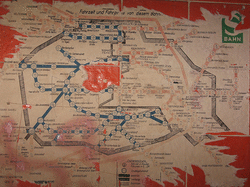Whether or not to
prep for upcoming disasters is totally up to you. You cannot make a one size
fits all preparedness plan. There are a lot of things to decide on when you are
prepping. Everyone has a unique situation such as, you live in an urban area,
you live in the suburbs, or you live in a rural area. When living in an urban
area such as, New York City, Boston, any large city. You have to prep
differently than if you were in a suburban or rural area. I am also a person,
that is never too late to start prepping. Even though, the economic and social
collapse of the United States government is close to fruition. I’m going to
give you some basic ideas about prepping an urban area. You can take these with
a grain of salt if you want but I do feel that these are just some of the
things you might want to do.
You need to come up
with a plan whether you are going to be able to put out or or bug in. You may
want a bug out plan, if you live near the edge of an urban area. This is only
if you have adults and older children that can travel quickly between same zone
to safe zone. There are several suitable and cost-effective bug out bags online. On the other hand,
if you have to bug in, because of young children below the age of 6 or you have
elderly parents they need to take care of. If this is your situation, you need
to come out with a bug in plan.
BUGGING OUT- First thing is you have to come up with an exit
strategy. I wouldn’t just plan one exit strategy, I would have several at least
three ways to get out of town. Just in case and areas blocked off by either the
government or roving gangs. Like I said before, this is only for adults and
older children, because they will be able to run quickly and hide quickly. In
this case, you just want to have a bug out bag. Most bug out bags have 72 hours
worth of food, first aid kit, and miscellaneous items that you need to survive
in the works for 72 hours. This means that you only have three days to get out
of the city. I recommend that a family should bug in for a couple weeks and let
the smoke blow over and then try to get out of the city. So this means you will
need some storable food and potable water stored and have enough for family of
four or whatever your family size is, for two weeks to a month. The longer you
stay out of the hands of FEMA, the better chance you have of survival. If you
have to walk around your neighborhood and draw a map. Find areas where you can
hide along the exit route, because you have to walk out of the city, because
the streets will probably be littered with cars that are empty, run out of
fuel, any number of reasons why. Know your exit route very well because if
something gets your way to where you can’t go your exit route you have to adapt
and change your plan as you go. This is the reason why a map of the area is so
critical. I’m not talking Street map! The map should be handmade street maps doesn’t
show the hiding places that buildings provide, you’ll need to get out of town.
BUGGING IN- I would only bug in, if I had obligations such
as, taking care of elderly parents and young children. If you live in the
center of the city, you might want to bug in you also. If you are bugging in,
you need to calculate how much food you would need for your entire family to
survive several weeks, if not several months. Many online storable food
websites have food calculators for those people who have mixed family of
adults, elderly and children. You will also need storage for potable water for
the same amount of time, depending on your water usage and depending on the
side of your family you should decide on how much you need. I KNOW I’M NOT
GIVING A LOT OF ANSWERS AND THAT IS BECAUSE EVERY FAMILY’S NEED TO SURVIVE IS
DIFFERENT. I know a lot of survival websites will give you a lot of advice or
tell you exactly what you to do. I’m not here to do that.
The basic items you will need, if the lights go out and
electricity just stopped working. Any disaster where you don’t have the basic
necessities these suggestions might help you. If you live in an apartment, in
the middle of the city and are limited on space. I would suggest getting a storage locker that
is close to you to store food and water in, because more likely than not have
enough room in your apartment to store some of the stuff you’ll need.
1.
A large army duffel bag.(More depending on
family size.)
5.
Several candles.
7.
as much peanut butter as you can get.(This is a
cheap way of getting something that is high in protein and I can be eaten on
the run.)
9.
A
hunting knife.(For
self-defense because most major cities are gun free zones, but that doesn’t
come into play, if there are other people with guns.)
12.
Handgun, if you can, with nine clips of ammunition.
15.
find people in your building that think the same
way you.(Allies are always a good thing.)
16.
Extra oxygen and medications for the elderly and
young children.
17.
Sewing kit.
18.
Heavy winter clothes.(You can always take off
clothes in the summer but you can never have enough clothes in the winter.)
19.
Have several escape plans. (Even if your bugging
in because you can’t stay there forever.)
20.
Have extra sharpened stakes to set booby-traps.
21.
Learn
self-defense.(krav maga, knife fighting, basic tactical training, anything
that will give you an advantage.)
22.
Stay in shape.( If you’re not in shape or fit.
You will not be able to escape.) Even if that means walking every day, because
every day you can walk further.
23.
Take a
tactical
weapons class. (This will come in handy even if you don’t have a weapon
because you may be able to acquire one later.)
24.
Read as many
survival
books as you can.(Every survival book has something a little different that
you can learn. Even if you’re in an urban environment, you can’t stay there forever
sooner or later you’re going to have to leave. Just don’t read one type of
survival book reads several different types survival in the woods, suburbs,
anything dealing with survivability)
25.
Be adaptable.(The more adaptable you are to your
situation or any coming situation the better off you will be. ADAPTABILITY IS
KEY ALWAYS REMEMBER THAT.)
26.
Sometimes you’re going to have to do things to
protect your family, that you would not do in a civil society. PREPARE YOURSELF
MENTALLY AND PHYSICALLY.
Now whether to prepare yourself for a disaster of any kind,
or not. This is purely up to you, if you’re real man and you want to take care
of your family during a disaster, start prepping now. The government is not
going to be able to help you in the time of the disaster. They have proven
themselves to be inept and unable to really help people in their times of need.
These are just suggestions, they are not guidelines. Prepping is an expensive
endeavor, but it will save your life and your family’s lives. People who depend
on the government to help them in the time and need have basically made their
family worth nothing. How much would you spend to ensure the safety of your
family. As for myself, there is no price high enough to ensure the safety of my
family. Whether you choose the prepper not, you need to ask yourself a question
how much is your family really worth.
there is no price
 amount of water shed will depend on heat, humidity, sunlight and the amount of water inside the plant. The way that we can harness is this wonderful and natural occurrence is with the use of a plastic bag…and the rays of that burning mass of gas called the ‘Sun’. Here are the steps:
amount of water shed will depend on heat, humidity, sunlight and the amount of water inside the plant. The way that we can harness is this wonderful and natural occurrence is with the use of a plastic bag…and the rays of that burning mass of gas called the ‘Sun’. Here are the steps: amount of water shed will depend on heat, humidity, sunlight and the amount of water inside the plant. The way that we can harness is this wonderful and natural occurrence is with the use of a plastic bag…and the rays of that burning mass of gas called the ‘Sun’. Here are the steps:
amount of water shed will depend on heat, humidity, sunlight and the amount of water inside the plant. The way that we can harness is this wonderful and natural occurrence is with the use of a plastic bag…and the rays of that burning mass of gas called the ‘Sun’. Here are the steps:



